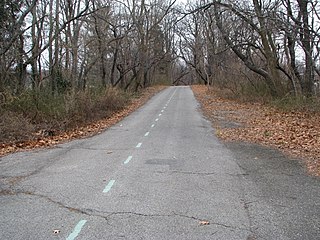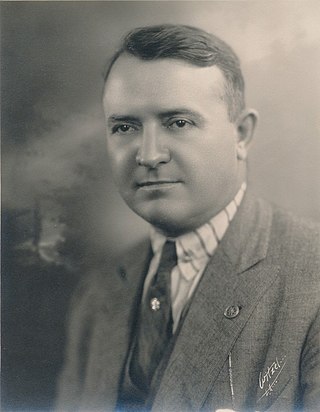
The Long Island Motor Parkway, also known as the Vanderbilt Parkway, Vanderbilt Motor Parkway, or Motor Parkway, was a roadway on Long Island, New York, in the United States. It was the first roadway designed for automobile use only. The parkway was privately built by William Kissam Vanderbilt II with overpasses and bridges to remove most intersections. It officially opened on October 10, 1908. It closed in 1938 when it was taken over by the state of New York in lieu of back taxes. Parts of the parkway survive today, used as sections of other roadways or as a bicycle trail.
The Locomobile Company of America was a pioneering American automobile manufacturer founded in 1899, and known for its dedication to precision before the assembly-line era. It was one of the earliest car manufacturers in the advent of the automobile age. For the first two years after its founding, the company was located in Watertown, Massachusetts. Production was transferred to Bridgeport, Connecticut, in 1900, where it remained until the company's demise in 1929. The company manufactured affordable, small steam cars until 1903, when production switched entirely to internal combustion-powered luxury automobiles. Locomobile was taken over in 1922 by Durant Motors and eventually went out of business in 1929. All cars ever produced by the original company were always sold under the brand name Locomobile.
Grand Prix motor racing, a form of motorsport competition, has its roots in organised automobile racing that began in France as early as 1894. It quickly evolved from simple road races from one town to the next, to endurance tests for car and driver. Innovation and the drive of competition soon saw speeds exceeding 100 miles per hour (160 km/h), but because early races took place on open roads, accidents occurred frequently, resulting in deaths both of drivers and of spectators. A common abbreviation used for Grand Prix racing is "GP" or "GP racing".

Berna Eli "Barney" Oldfield was an American pioneer automobile racer; his "name was synonymous with speed in the first two decades of the 20th century".

Raffaele "Ralph" De Palma was an Italian-American racecar driving champion who won the 1915 Indianapolis 500. His entry at the International Motorsports Hall of Fame estimates that he won about 2,000 races. DePalma won the 1908, 1909, 1910, and 1911 American AAA national dirt track championships and is credited with winning 24 American Champ car races. He won the Canadian national championship in 1929. DePalma estimated that he had earned $1.5 million by 1934 after racing for 27 years. He is inducted in numerous halls of fame. He competed on boards and dirt road courses and ovals.

Ferenc Szisz, was a Hungarian race car driver and the winner of the first Grand Prix motor racing event on a Renault Grand Prix 90CV on 26 June, 1906.

William Kissam Vanderbilt II was an American motor racing enthusiast and yachtsman, and a member of the prominent Vanderbilt family.

The Vanderbilt Cup was the first major trophy in American auto racing.

Dario Raoul Resta, nicknamed "Dolly", was an Italian Briton race car driver. He was the winner of the 1916 Indianapolis 500.

Ralph Moody was an American stock car racer. He eventually became a team co-owner of Holman Moody.

Ralph Kirkman Mulford was an American racecar driver who participated in the 1911 Indianapolis 500. In 1911 he won the Vanderbilt Cup in Savannah, Georgia.

Charles Cleveland Merz was an American racecar driver, military officer, engineering entrepreneur, and racing official. Active in the early years of the Indianapolis 500, he later became Chief Steward of the Memorial Day Classic.
Lee Frayer was an American racecar driver who competed in the 1911 Indianapolis 500. Driving a Firestone-Columbus automobile, Frayer won a 100-mile race in Columbus, Ohio, defeating, among others, the great Barney Oldfield.
The 1906 Grand Prix season is regarded as the first Grand Prix racing season. It marked the advent of two iconic races: The French Grand Prix and the Targa Florio.

Joe Tracy was a racing driver born in Waterford, Ireland who emigrated to the United States at age 19 and became an American citizen. He drove a Locomobile in the 1905 Gordon Bennett Cup but was eliminated by a stripped gear after two laps and later competed in that year's Vanderbilt Cup race, finishing 3rd, the best result for an American car in an international race at the time. He retired from racing shortly after the 1906 racing season where he had good finishes in both the Vanderbilt and Bennett Cups. He was retroactively awarded the 1906 National Championship in 1951.
The 1906 Vanderbilt Elimination Race was a motor race run to decide which five cars would represent the United States in the international 1906 Vanderbilt Cup.

Tom Cooper was an American cyclist and early automobile racing driver. He is best known for his rivalry with cyclist Major Taylor, as well as his later work with Henry Ford and Barney Oldfield.
The AAA Contest Board was the motorsports arm of the American Automobile Association. The contest board sanctioned automobile races from 1904 until 1955, establishing American Championship car racing. Modern-day IndyCar racing traces its roots directly to these AAA events.

Albert Clément was a French motor racing driver. In 1904 he won the II Ardennes Cup race and finished third in the III Ardennes Cup race at Bastogne. He also finished second in the Vanderbilt Cup on Long Island. In 1906 he finished third in the inaugural French Grand Prix and 4th in the Vanderbilt Cup. All his driving was in the Clément-Bayard factory team that was owned by his father Adolphe Clément-Bayard.

George Hepburn Robertson was an American racecar driver. His father ran one of New York's first big garages and Robertson grew up surrounded by Mors, Panhards and other cars.













